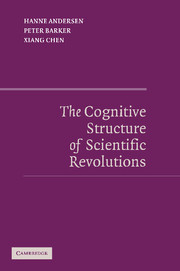Book contents
- Frontmatter
- Contents
- List of Figures
- Acknowledgments
- The Cognitive Structure of Scientific Revolutions
- 1 Revolutions in Science and Science Studies
- 2 Kuhn's Theory of Concepts
- 3 Representing Concepts by Means of Dynamic Frames
- 4 Scientific Change
- 5 Incommensurability
- 6 The Copernican Revolution
- 7 Realism, History, and Cognitive Studies of Science
- References
- Index
5 - Incommensurability
Published online by Cambridge University Press: 18 July 2009
- Frontmatter
- Contents
- List of Figures
- Acknowledgments
- The Cognitive Structure of Scientific Revolutions
- 1 Revolutions in Science and Science Studies
- 2 Kuhn's Theory of Concepts
- 3 Representing Concepts by Means of Dynamic Frames
- 4 Scientific Change
- 5 Incommensurability
- 6 The Copernican Revolution
- 7 Realism, History, and Cognitive Studies of Science
- References
- Index
Summary
INTRODUCTION
In this chapter we will use the methods introduced in previous chapters to clarify and extend Kuhn's mature account of incommensurability. We will show that incommensurability between conceptual structures is created by changes that are neither total nor instantaneous. We will also draw out various conclusions that Kuhn suggested but did not elaborate, for example, that incommensurability varies in degree or importance and that the degree correlates with the position of a concept in a hierarchy or conceptual structure as depicted by the corresponding frame. Throughout the next two chapters our main historical focus will be the Copernican revolution, an episode that Kuhn never treated satisfactorily (Westman 1994; Barker 2001). On the basis of our new account, we will suggest that incommensurability may occur even within what Kuhn and earlier writers have regarded as a single paradigm and that this kind of conceptual difficulty may in itself be a motive for conceptual revision. As we will see in Chapter 6, one of the most important motives for Copernicus' revision of Ptolemaic astronomy was a problem of just this type.
THE DEVELOPMENT OF KUHN'S CONCEPT OF INCOMMENSURABILITY
Kuhn significantly refined his philosophical account of science in the years after the publication of The Structure of Scientific Revolutions. The concept of incommensurability also underwent major revisions. From an initial description that emphasized similarities to visual gestalt switches, Kuhn moved in the 1980s to an account that described incommensurability in solely linguistic terms.
- Type
- Chapter
- Information
- The Cognitive Structure of Scientific Revolutions , pp. 104 - 129Publisher: Cambridge University PressPrint publication year: 2006

